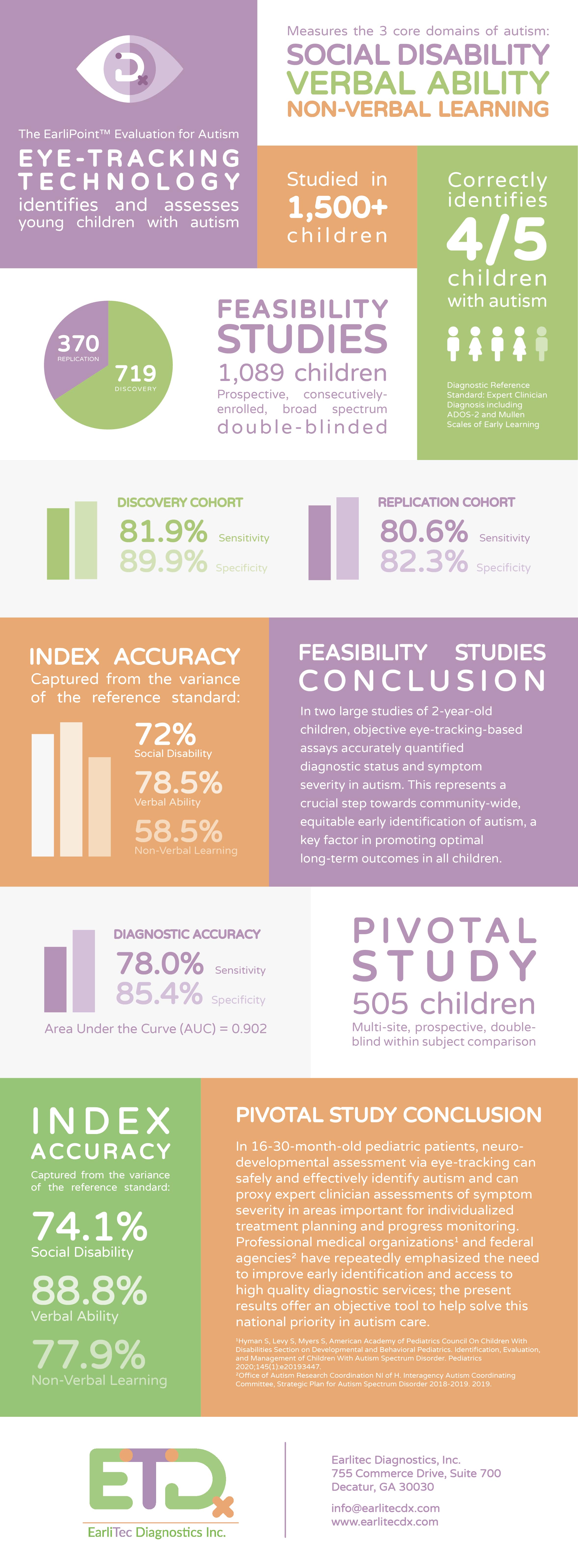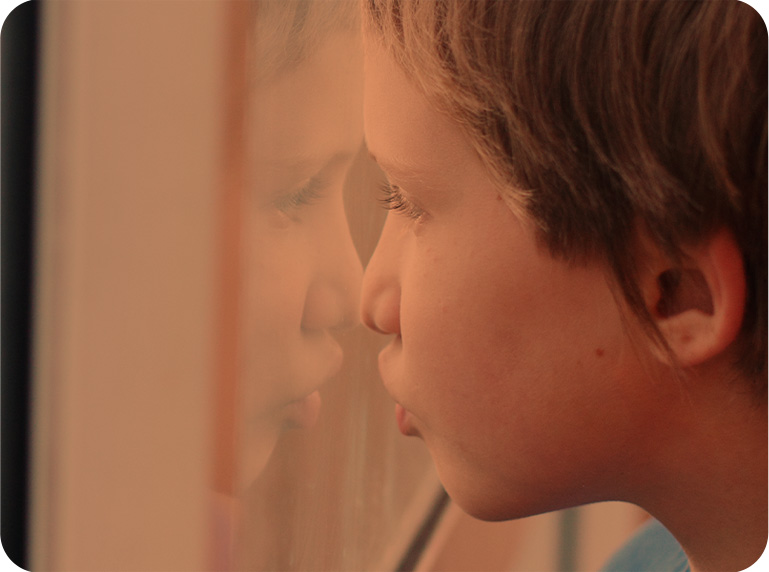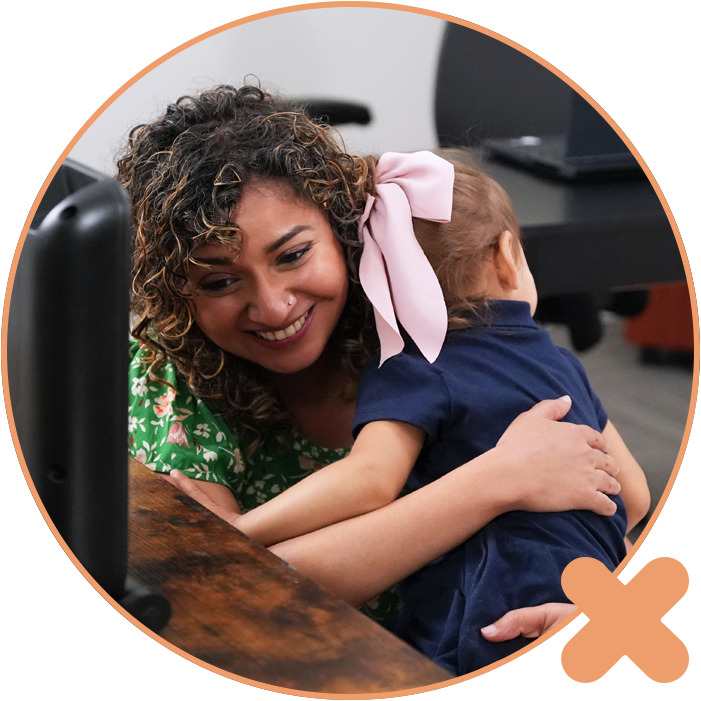Today EARLIPOINT gives you the power to unlock their diagnosis starting as early as 16 months!
If ever there were a moment when science feels like magic, then this is probably it. Our FDA–authorized tool allows you to conduct reliable assessments of children as they do something they love to do—watch a screen. The EarliPoint product uses A.I. eye tracking technology to scan a child’s eye movement at a rate of 120 times per second. At the glance of an eye you’ll be able to analyze patterns that could indicate the presence of autism in a child. It’s time to embrace the power of the EarliPoint diagnostic and assessment tool.
NEW STUDIES
EarliTec’s recent studies, featured in The Journal of the American Medical Association (JAMA), reveal the effectiveness of quantifying moment-by-moment looking behavior as a biomarker for objectively assessing the presence or absence of autism. These studies also measure individual children’s functioning across the three core domains of autism – social disability, verbal ability, and nonverbal learning.
Read our most recent studies below or find links to past studies at the bottom of this page.

Eye-Tracking-Based Measurement of Social Visual Engagement Compared with Expert Clinical Diagnosis of Autism.
September 5, 2023
Development and Replication of Objective Measurements of Social Visual Engagement to
Aid in Early Diagnosis and Assessment of Autism.
September 5, 2023


Looking Behavior & Autism
It begins at a very early age. Children learn and grow by observing and interpreting shared experiences.
Through social interactions, they begin to assess words, vocal tone, facial expressions and other cues that help them understand the world. This focus, or looking behavior, plays an important role in how our social development, communication skills and reasoning develop.


From birth to six months

Looking behavior in children with autism tends to differ from typically developing children, such as focusing on objects rather than faces, with important learning opportunities being missed in every social interaction. Studies have shown that atypical social visual engagement (e.g., focus on things versus people) can be observed within the first six months of an infant’s life. These observations are predictive of a diagnosis of autism later in childhood. Measuring these missed opportunities helps us determine where a child falls on the spectrum to give parents and providers the know-how to work with an individual child in order to achieve the greatest gains in their development.
previous STUDIES
In a landmark study of 338 typically developing and atypically developing toddlers, including a large set of identical and fraternal of twins, participants underwent a series of eye-tracking experiments to assess preferential attention and moment-by-moment looking behavior as they viewed dynamic social scenes. The researchers found that differences in the viewing patterns, were under strict genetic control. Moreover, these natural viewing patterns segregated toddlers with autism from those without it.2
These and other studies3-8 defined atypical looking behavior as a neurodevelopmental endophenotype for autism and laid the foundation for understanding individual development when social visual engagement is impaired at an early age. Because social experience aids intellectual, behavioral, and communicative development, children whose attention drifts to less salient aspects of social situations miss opportunities for social learning and development, which accrue by the thousands over the first 2-3 years of life.
This understanding is the basis for our work and our mission to make earlier identification and treatment for autism and related disabilities accessible to children everywhere.
References
1. Jones, W. & Klin, A. Attention to eyes is present but in decline in 2–6-month-old infants later diagnosed with autism. Nature 504, 427–431 (2013)
2. Constantino, J., Kennon-McGill, S., Weichselbaum, C., Marrus, N., Haider, A. Glowinski, A., Gillespie, S., Klaiman, C., Klin, A., Jones, W., Infant viewing of social scenes is under genetic control and is atypical in autism. Nature 2017 Jul 20; 547:340-344
3. Shultz, S., Klin, A. & Jones, W. (2018). Neonatal transitions in social behavior and their implications for autism. Trends in Cognitive Sciences, 22(5):452-469.
4. Rice, K., Moriuchi, J., Jones, W., & Klin, A. (2012). Parsing heterogeneity in autism spectrum disorders: visual scanning of dynamic social scenes in school-age children. Journal of the American Academy of Child and Adolescent Psychiatry, (51)3, 238-248.
5. Shultz, S., Klin, A. & Jones, W. Inhibition of eye blinking reveals subjective perceptions of stimulus salience. Proc. Natl Acad. Sci. USA 108, 21270–21275 (2011)
6. Klin, A., Lin, D. J., Gorrindo, P., Ramsay, G., & Jones, W. (2009). Two-year-olds with autism fail to orient towards human biological motion but attend instead to non-social, physical contingencies. Nature, 459, 257-261.
7. Jones, W., Carr, K., & Klin, A. (2008). Absence of preferential looking to the eyes of approaching adults predicts level of social disability in 2-year-olds with autism. Archives of General Psychiatry, 65(8), 946-54.
8. Klin, A., Jones, W., Schultz, R., Volkmar, F. & Cohen, D. Visual fixation patterns during viewing of naturalistic social situations as predictors of social competence in individuals with autism. Arch. Gen. Psychiatry 59, 809–816 (2002)



